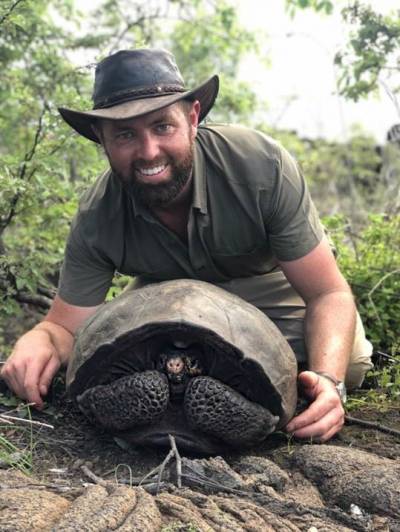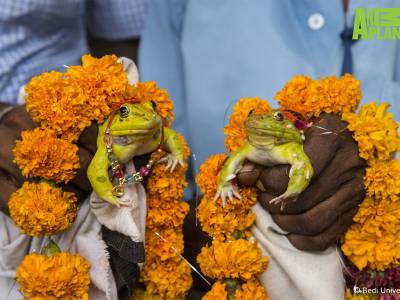‘Extinct’ tortoise rediscovered in Galapagos after 113 years
Host and leading biologist, Forrest Galante always believed the Fernandina Tortoise may still exist and on February 17th 2019, after 2 days of surveying, his team, including a Galapagos National Park Ranger (Jeffery Malaga) and the Director of the Galapagos Conservancy (Washington Tapia), crossed a three mile stretch of hardened lava flow to arrive at an area identified the previous day as potential habitat that could support a population of Fernandina tortoise.
Having positively identified tortoise scat in the field, the team led by Galante successfully located an active bedding site before finding the animal nearby. The tortoise was found sheltering from the equatorial sun, buried deep under a pile of brush. A huge celebration ensued as all parties involved were able to positively identify the animal in question as an older female C.Phantasticus based on shell morphology and facial characteristics.
A team of international turtle biologists at the Turtle Conservancy studied photos and video of the tortoise and confirmed it is likely to be Chelonoidis phantasticus. "Since only one other specimen of this species has ever been found (a deceased male collected in 1906), we have never seen a female of the species," said Anders Rhodin of the Turtle Conservancy and IUCN specialist group. "The photos from the team clearly show a moderately saddle-backed, old female about half to twothirds the size of the known male. Pending genetic confirmation, this is almost undoubtedly the lost Fernandina Giant Tortoise." In celebration of this historic discovery, the Turtle Conservancy and Global Wildlife Conservation are pledging a $100,000 match to further conservation efforts of the Fernandina Giant Tortoise. To have your donation matched, go to www.globalwildlife.org
The tortoise is in good health but underweight, unsurprising considering the sparse vegetation in the area she lived in on the volcano. She has been taken to the Fausto Llerena Tortoise Breeding Center, a national park facility in Isla Santa Cruz. This facility will ensure her ongoing survival, a healthy diet and perhaps, if sperm retention has occurred, fertile eggs and offspring. The hope is that her discovery will prompt new searches and ongoing funding for the location of a suitable mate with the ultimate goal of re-releasing many healthy animals back onto the island. The breeding center has successfully bred and re-released 4000 Galapagos tortoises since its inception.
“As a biologist and someone who has dedicated my life to the pursuit of animals believed extinct, this is by far my greatest scientific accomplishment and proudest moment,” said Galante. “Much like Lonesome George was an icon of extinction, I believe she can become an icon of wildlife hope. She’s the rarest tortoise, if not animal, in the entire world and one of the largest discoveries in the Galapagos in the last century,” said Galante.
Susanna Dinnage, Global President of Animal Planet said, “We are moved and excited about this historic news. As the rate of animal extinction is widely debated, it gives us great hope that some species are surviving against the odds and that at Animal Planet we can do our bit to celebrate and support them”.
The television crew that follows Galante documented the entire expedition and it will be featured as an episode of Animal Planet’s Extinct Or Alive in the summer of 2019 worldwide.





















Share
Facebook
YouTube
Tweet
Twitter
LinkedIn